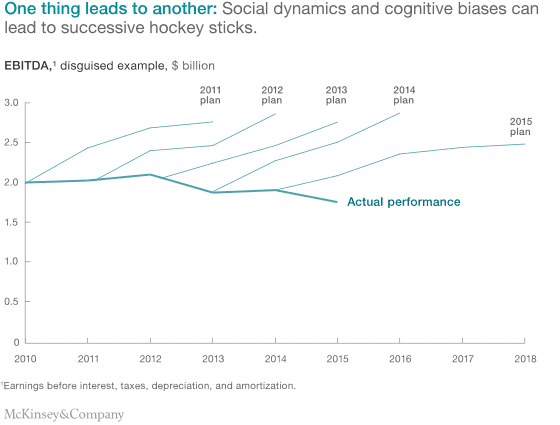A Field Guide For Creating Real Momentum Among Teams
Nearly all leaders I meet love strategy as a topic. They talk and think about it a fair lot. In many organizations, however, strategic projections remain lofty visions while actual performance lags. Have a look at this graph from McKinsey:

What gets in the way? Why do strategic plans often fail?
It’s true that frameworks for defining a strategy and breaking it into a strategic plan aren’t that simple – but they aren’t that complicated either. Yes, strategic planning requires discipline and a systematic process. But that kind of process and facilitation expertise is widely available – bring in an in-house or external strategic planning consultant.
In many cases, it’s the social side of strategic planning that is the challenge. As I recently wrote in “Best of both: Get cross-functional and strategic alignment in one swoop”, the human element in the strategic planning process is easily underestimated – and so is the grip of cognitive biases and our need to protect our self-worth and sense of security (e.g., “I can control this…”). Defining a strategy and planning strategic execution isn’t just a rational process. It’s a highly emotional one – personally and interpersonally:
Leaders and stakeholders have emotions and cognitive biases tied up in making strategic decisions. So when it comes time to fully commit to a decision, their thoughts and emotions are holding them back and ultimately they can’t “put their money where their mouth is.”
In order to get buy-in that is not simply “lip service,” but a true “all for one and one for all” effort, a team needs to balance the strategic/rational side of the strategic planning process with the emotional aspects. Enthusiastic buy-in into your strategy statement entails members committing to the entire process – not just the end product.
Want to audit the mental health aspect of your strategic plan? Here is a checklist:
- Get all cross-functional stakeholders involved from the start – so everyone feels they are an important part of the process. Yes, you have heard that before and may you think “everyone is saying this all the time”. That’s because few teams actually do well on including the right folks early on. You want to create alternatives and discuss trade-offs together from the start vs. having some key stakeholders join late when favorite ideas have emerged already. People feel “psychological ownership of their ideas” which is why smart people defend stupid ideas. Get together before select people have their very own dog in the race
- View strategy conversations as an ongoing conversation – not a one-time event – and plan “cadences” accordingly. You shouldn’t need to review your sense of purpose annually, but you sure need to review your strategic priorities and down-stream planning annually to see if you are moving towards your vision
- Offer a clear, compelling framework to discuss strategy and a clear, compelling process for strategic planning – so everyone has faith that this strategy discussion will go somewhere
- Start with the big picture: You need a shared sense of purpose to inspire passion, and you need a vision to align action. Resist the urge to focus on building on what’s there. Take a step back and observe the company from a bird’s eye view first. Asses what is before planning what will be.
- Make it psychologically safe to honestly talk about doubts: The “hockey sticks” are often a result of making half-hearted vs. making bold moves
- This, in my experience, is the biggest crux: Making “moves that make a difference” – and getting people on the same page about risks/rewards
- Make “bold moves” more easily: Give yourself and your stakeholders time between sessions to get data and evidence required to take informed risks that make a real difference with confidence vs. playing is safe by polishing the status quo
- Discuss real alternatives in depth, don’t gloss over them – explore at least two or three
- Think about the budget for your strategic moves from an overall business perspective vs. driving strategy from one function only (sales, R&D, marketing, customer experience, etc.)
- Ask “Can we say it?”: Check if everyone on the leadership team on the same page regarding mission, vision, and strategic priorities and required capabilities
- Only now involve the folks who would own the implementation to hash out planning details and to explore cross-functional opportunities/dependencies. This will foster their emotional buy-in. With them, ask “Do we live it?” to make sure actions and capability building are truly focused on what your organization does best and what furthers differentiation.
- Create some compelling and pithy visuals that state your strategy and key milestones and use those visuals as your “hymn sheet.” I encourage teams to: communicate, communicate, communicate – have everyone deliver the same message for a feeling for oneness, alignment, and momentum.
“Planning is everything, the plan is nothing.”
Dwight Eisenhower
The overall feeling of safety to explore and commit to the strategic plan is an essential part of the process. Stakeholders and employees alike will feel empowered to make bold moves and avoid hockey sticks, only after considering all opportunities, assessing risks, and acknowledging doubts from both a process and a human perspective.

